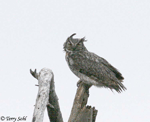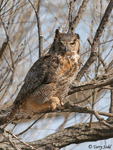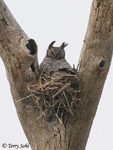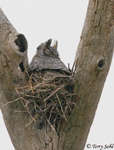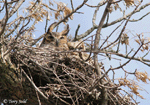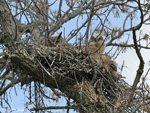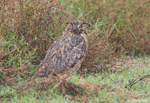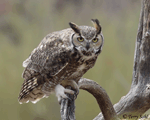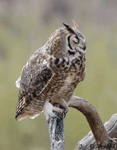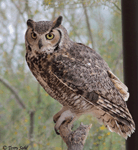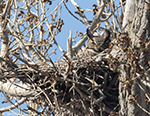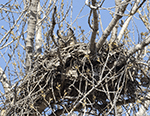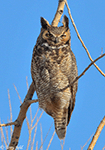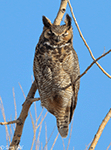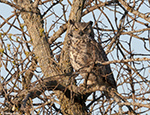| Length: 19 to 25 inches | Wingspan: 40 to 60 inches | Seasonality: All Seasons |
| ID Keys: Large ear tufts, large size, yellow eyes, horizontal belly bars. | ||
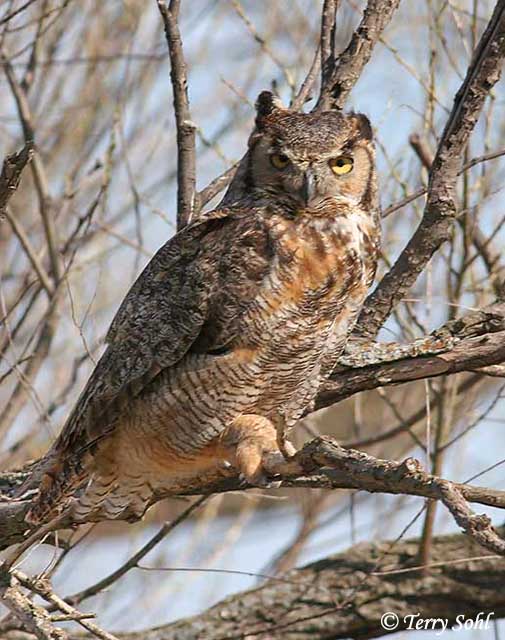 The
Great Horned Owl is the most widespread owl in North America, being found from
the treeline near the Arctic south through the rest of the continent.
Powerful predators, they will take prey larger and heavier than themselves.
Great Horned Owls are among the earliest nesting birds, starting as early as
mid- to late-winter.
The
Great Horned Owl is the most widespread owl in North America, being found from
the treeline near the Arctic south through the rest of the continent.
Powerful predators, they will take prey larger and heavier than themselves.
Great Horned Owls are among the earliest nesting birds, starting as early as
mid- to late-winter.
Habitat:
In general, Great Horned Owls prefer forested areas with adjacent open lands. However, they are incredibly adaptable and can be found in nearly any habitat in North America, from the treeline in far northern Canada and Alaska, to the deserts of the southwestern US and Mexico.
Diet:
Wide variety, with more mammals than other types of animals. Will eat rabbits and hares, rats, mice, ground squirrels, skunks, opossums, snakes, lizards, frogs, large insects, and birds up to the size of geese. They will take larger prey relative to their size than many birds of prey, even taking on porcupines and similarly sized prey.
Behavior:
Primarily nocturnal, although they will occasionally hunt in the late evening or during the day (particularly during breeding season). Usually hunts by observing from a high perch and swooping down to capture prey once spotted.
Nesting:
January through May in South Dakota, Great Horned Owls are one of the earliest nesting birds in the state, with pairs hanging around nesting sites for several weeks before they actually begin nesting and courting calls occurring throughout that period (as early as December in South Dakota!). They nest in a very wide array of locations, using repurposed nests of other species, cavities in trees or caves, or in abandoned buildings or other man-made structures. Stick nests from other species such as hawks or ravens may be augmented with additional material or not, while nests in cavities may be lined with softer materials such as down, fur, leaves, moss, or other vegetative material. The female lays between 1 and 5 eggs, and she does the majority of incubation. Incubation last 4 to 5 weeks. The young fledge from the nest about 6 weeks after hatching.
Song:
Both the male and female have hooting calls that are given during an extended courtship period early in the breeding season (beginning as early as December). A wide variety of other vocalizations are sometimes given as alarm calls, contact calls, or communication around the nest. Click below to hear various calls of the Great Horned Owl.
Migration:
Permanent resident throughout its range, although individuals may wander widely.
Interactive eBird Map:
Click here to access an interactive eBird map of Great Horned Owl sightings
Similar Species:
Given that many owl sightings occur near dawn or dusk when lighting isn't great, here are other large owl species in South Dakota that could potentially be confused with a Great Horned Owl.
- Long-eared Owl - Long-eared Owls aren't as common in South Dakota, but they can sometimes be found in the same general vicinity as Great Horned Owls. Given they're also the other large South Dakota owl with very prominent ear tufts, and they're probably the easiest owl to potentially confuse with a Great Horned Owl. They are quite a bit smaller than a Great Horned Owls, as well as more slender. The shape of the facial disk is different as well, with Long-eared Owls generally having a "longer" (taller) looking face because of more vertical extension on the facial disks, and Great Horned Owls having a proportionally "shorter" face.
- Barred Owl - Barred Owls are just a little bit smaller than a Great Horned Owl. Their underparts have vertical barring, while the underparts of a Great Horned Owl have very fine horizontal barring. The eyes and bill of a Barred and Great Horned Owl are "reversed", with Barred Owls having dark eyes and a yellowish bill, and Great Horned Owls having yellow eyes and a dark bill.
- Short-eared Owl - Short-eared Owls are smaller than a Great Horned Owl, and lack prominent ear tufts (although depending upon the position of the bird, very short ear tufts may be visible). Short-eared Owls also have vertical barring on their underparts, while Great Horned Owls have very fine horizontal barring.
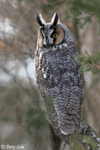 |
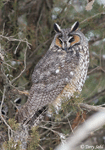 |
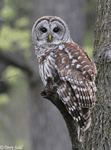 |
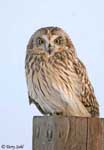 |
| Long-eared Owl | Long-eared Owl | Barred Owl | Short-eared Owl |
Conservation Status:
Widespread and common, with no apparent significant population declines (as noted by Breeding Bird Survey and Christmas Bird Count data). The IUCN considers the Great Horned Owl to be a species of "Least Concern".
Further Information:
- USGS Patuxent Bird Identification InfoCenter, Great Horned Owl
- BirdWeb - Great Horned Owl
- Audubon Guide - Great Horned Owl
Photo Information:
April 13th, 2006 - Minnehaha County - Terry Sohl
Additional Photos:
Click on the image chips or text links below for additional, higher-resolution Great Horned Owl photos.
Audio Clip Credits:
- 1Sue Riffe, XC450332. Accessible at www.xeno-canto.org/450532
- 2Luciano Buck, XC459594. Accessible at www.xeno-canto.org/459594
- 3Lance A.M. Benner, XC444651. Accessible at www.xeno-canto.org/444651
| Click on the map below for a higher-resolution view |
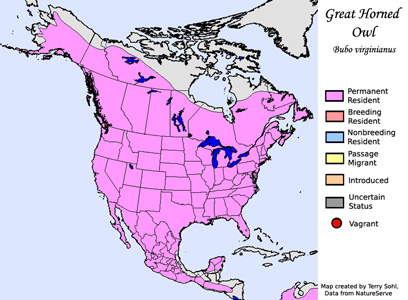 |
| South Dakota Status: Common permanent resident throughout the state. |
Additional Great Horned Owl Photos
Click for a higher-resolution version of these photos
